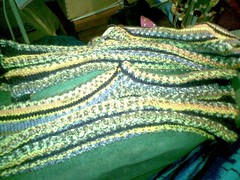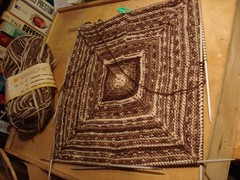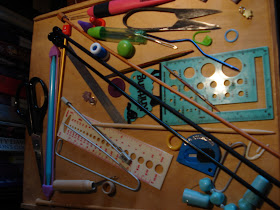Now I've read a lot of books about knitting, many of them are the 101 types. They often talk about essential equipment.
Here's my list of the essentials
Yarn: before you start knitting you will need at least a little bit of this. Why do I start here? Well what yarn you choose will depend on the needles you need for it. Fine yarn can be fiddly and you won't see much progress but a very thick yarn can be clumbsy and the needles feel big in your fingers. Most people in Ireland started on Aran weight or DK weight yarns. Don't start with black yarn. Experienced knitters swear at black yarn, don't weigh the odds against you. Find a yarn that you like the texture of and is cheap, but not the cheapest acrylic you can find, you will want to like doing this, texture can be important. However, try to use a smooth yarn for your first moment out. You will want to be able to see what the knitting looks like. Try not to fill your bag with yarn, trust me, you mightn't like knitting.
Next up you'll need needles. Look at the yarn, there should be a symbol with a grid on it with a pair of needles underneath, or needles and crochet hook, it will have various numbers on it, usually one has mm after and one will have US after it, that's the needle size. If the needlsize is a range, pick something in the middle of the range. If 4mm falls somewhere in your range pick that one. You can get kids 4mm needles in metal for very cheap, they're short like pencils, and they're a bit rough but I use them regularly for knitting facecloths.
Things that would be useful at this stage: tape measure, well a ruler will do too, the tape measure is useful when you move to making garments, so you can check your measurments, but when you're first out a ruler will do, and if you can get a short one, even better! They fit nicely in knitting bags.
A blunt-ended yarn needle is probably a good investment too, you'll need it to finish off a piece, even if it is a washcloth.
A reasonably good scissors - actually the kids craft scissors is really useful for a carry around, you won't get poke-through on your project bag. You will eventually need more scissors than you think. They're up there with tape measures for getting lost and forgotten.
Now you can knit: Washcloths, plain scarves and many other things.
Next up:
first I'd get: Pins (when you start doing gauge or pinning out stuff these are essential) knitters pins can make counting gauge easier but they're not essential.
A Cable needle (or 3, they often come in sets of 3) will be useful if you start doing cables, I've also used the blunt ended needle, paperclips and other things to do this job. There are folks who can do cables without needles, I can, I still prefer using the tool.
Needle Gauge. Oh yeah, the needles will say something, DON'T trust them. There are folks who use micrometers to fine tune their gauge, my tip? Once you get gauge, check what size you're using and if you break a needle or the sofa eats it double check that the needle you're replacing it with matches as closely as possible. Note the size down somewhere, ravelry, on the pattern, on a postit stuck to the pattern, somewhere!
If you're working with metal needles you now need to go out and buy some plastic and some wooden needles. Compare and contrast these, seriously, they do make a difference. I have some of all of the above. There are advantages and disadvantages to them all. If your lips start tingling that could be the finish, I have some older aluminium needles that I have no problem with and the knitpicks metal dpns make my lips tingle every time. Speaking of knitpicks they have a entry-level set of their inter-changables that feature a metal, wood (laminate) and plastic needle in different sizes, useful for this.
Circular needles and double pointed needles are essential when you start into knitting more stuff. Many folks with hand issues use circular needles for everything, back and forth. They're also used for knitting in the round. Socks, jumpers, gloves etc. And Medalion knitting.
Bobbins- only if you get into colourwork, and then they can be made from cereal boxes if you're stuck.
Ring Stitch Markers - can also be made from a knotted loop of contrast yarn, or a straw. They're useful, come in a lot of varieties and you'll probably collect a nice collection over time, which make pretty ornaments... You can also get some that are like little coilless safety pins. These are amazing little things - that dropped stitch, put it into this until you get to it to fix it; use it to count stitches when you're casting on; mark the front of a project; pretty much anywhere you need a mobile marker.
Stitch Stoppers. Essential if you have too many stitches on a needle or putting something away for a while, and when I say essential, I mean I have some I rarely use. I've pulled needles out of projects more often than I want to think about, I probably should use these, you can live without them.
Row Counter - there are several variants on this theme, this can also be replicated with a notepad or postits (postits can be useful for sticking to the right place in a pattern) and a pencil or pen.
Crochet Hook - well you might want to try crochet too and this can be essential for helping you pick up stitches. When picking up stitches it can be useful to use a hook a size (or two) smaller than the needle size you're working with.
This is a selection of my knitting gadgets. Many of which are complete garnish.
Garnish: Not necessary but can be so good.
Posh dressmaking scissors and or embroidery scissors. Yeah, these can be useful later. Steeking may happen, buttonholes may be needed, felt may need to be cut, good quality scissors will make this easier.
Safety snips - for travelling on airplanes, they're quite useful to put into your project bag so you don't forget and then lose a good scissors to the airport security. Some folks have suggested unwaxed dental floss holders. The cutter on it is useful and the unwaxed floss can be used for lifelines or provisional cast-ons.
Knitting Bag - I have one, I also use a tonne of cloth bags I got over time buying stuff in Ireland (we have a plastic bag tax and almost everywhere has these bags) and I have a cosmetics bag that is a perfect portable socks project bag (though failing these days)
A large white lint-free towel - for blocking purposes, and for drying woolens. To be carefully cleaned and kept for this. It won't transfer colour to elsewhere.
A sweater dryer/rack - I have one that goes on the bath, it's really useful for drying socks too!
Blocking boards - something you can pin your finished job to, I have some large padded floor tiles that I use. Many friends use children's play tiles, damp a white/pale cloth, pin it to the tiles when you get them and check that they won't run.
A folder for storing patterns, you'll probably start with only one.
You'll need an ironing board and iron. Sometimes things need to be pressed before moving on, a good ironing board can be used to block small items too, or even to block something in stages.

 Brown Cardigan, I was getting there with this until I discovered that the armholes aren't designed for me. Sleeves need to be ripped and restarted. Yes, this is knit in an interesting modular way and I liked the fun of it.
Brown Cardigan, I was getting there with this until I discovered that the armholes aren't designed for me. Sleeves need to be ripped and restarted. Yes, this is knit in an interesting modular way and I liked the fun of it.







